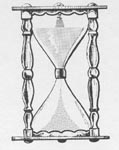Notice: You may
also want to visit the
Swedish-English
Pictorial Dictionary. Almost all of the Swedish words in the
bouppteckningar listed here are included in that dictionary with alternate
spellings, English translations, pictures, and sometimes additional
information on the subject.
INTRODUCTION TO BOUPPTECKNING TRANSLATIONS
The Swedish bouppteckning is a legal
proceeding resulting in a document containing a wealth of information of great
interest to genealogists. Soon after a death, the heirs assemble with persons
experienced in the required procedures and legalities. The task at hand is to
record an inventory of all items in the estate of the deceased and assign a
value to each item.
The document resulting
contains this estate inventory, a summary of all outstanding debits and
credits, identification of the heirs and any representatives thereof,
identification of those conducting the procedure, and legal certifications as
required by laws and customs of the given time. It may also explain unusual
circumstances specific to this particular estate.
Not all deaths resulted in a
bouppteckning. Factors increasing the odds were male decedents,
married persons, surviving minor children, significant assets, high social status, and persistence of
the court which had jurisdiction. Factors decreasing the odds were female
decedents, unmarried persons, poverty, lax court systems, and of course youth.
In addition to personal
attributes, other factors affect the chance of finding and/or deriving
information from a particular bouppteckning. Although Swedish record
keeping over the years was truly remarkable, aging of records, fires, water
damage, insect damage, lax protection, poor quality papers and inks, and even
poor penmanship took their toll.
I’ve been fortunate enough to
find the records for a number of my ancestors and with lots of help from
Swedish relatives and friends, online lists, dictionaries and translators, and
of course the miracle of search engines, I’ve taken a shot at extracting the
old Swedish and translating it to English. I present these bouppteckning
translations for other English speaking persons who may be attempting similar
projects. The Swedish (as I have transcribed it) and the English (as I have
translated it) are presented side by side. The original images are also
available, usually in a separate window so you can position it as you like on
your computer and zoom in for better visibility.
Credits - These are some of
the most valuable sources for the information presented here - I list them
with gratitude::
Hippocrene
Standard Dictionary 1993, Vincent Petti and Kerstin Petti
Swedish Genealogical Dictionary 2000, Phyllis J. Pladsen, et
al.
SweGGate,
Dr. Fredrik Haeffner
Hans
Högmans Släktforskning, Hans Högman
Kjell Gärme, a good friend who has spent many hours researching and
advising
Ulf Sandin, not a relative, but a very helpful friend
Elisabeth Thorsell, Editor of Swedish American Genealogist
Bo Johansson, an extremely productive member of the
Sweden List
Rötter
Anbytarforum, a friendly place to ask Swedish genealogy questions -
Anna-Carin Betzén,
Heikki Särkkä, et al.
Google and the almighty World Wide Web
A few caveats are probably in
order. I have made only a little effort to understand subtleties.
For example, the words kar, såå, and tina
(and sometimes even tunna and tråg) all seem to translate to the
English word "tub". Since the recorders saw fit to use the various
words, I'm sure they did so to *differentiate* one from another, however the
nuances have not been revealed to me. I did choose to translate tunna
as "barrel" sometimes and "cask" sometimes, and tråg usually as
"trough", just because context seemed to call for it.
I also admit to making some
guesses based on phonetic similarities (kott sounds a lot like "coat",
rep sounds a lot like "rope"), spelling variations (c=k=ck, j=i,
kj-tj, fv=fw=f=w=v),
etc.
I will be adding a Frequently
Asked Questions page soon - I know that many concepts (e.g.,
röjselrätt) and obscure words and
phrases (e.g.,
kamlott and kalmink) need explanation. Have patience, I'm an old duck!
All the work you see here is
subject to correction. I’ve done the best I can, but I don’t speak Swedish
nor do I have the “Swedish eye” required to derive modern Swedish from the
somewhat “creative spelling” of certain scribes. I would be delighted to hear
from you with corrections, suggestions, discussions, and comments on any of
these bouppteckning translations! Please contact me by clicking
here or
here.
GENEALOGICAL
RESOURCES
HOME
[Visitor number 
